Chapter Eight
There are as many ways to organize the cooking and menu planning on your trip as there are people. Everyone has a system or a variation on a system that they think is the absolute best. Realistically all of them work. The important thing is organization. If everyone understands how the meals are going to work, no one goes hungry.
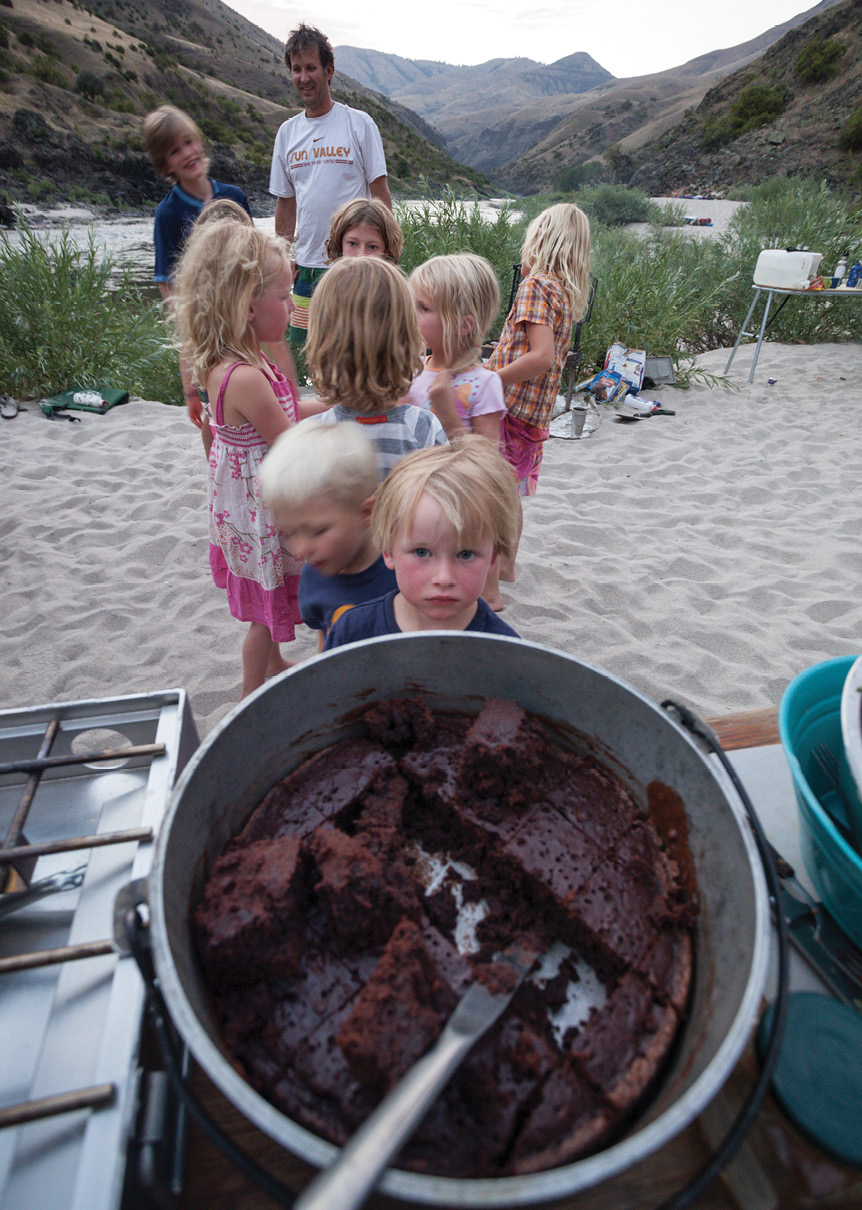
You probably won’t lose weight on a river trip as the food is usually good and plentiful, plus you can always eat cake.
One of the simplest ways to figure out your food is to hire an outfitter to plan, prep, and pack all of your meals. When you go this route, you usually end up with bags or boxes of food organized by day with preparation instructions included. This system works great, but it’s not the cheapest route to take.
Another system is to create cook teams responsible for planning and preparing a certain number of meals during the trip. How you organize your schedule is up to you. Some people like to have one team do all the meals on one day. Some people like to have a team start with dinner and go through lunch the following day. Some people like to do group breakfasts and dinner and have individuals bring their own lunches. Regardless of how you line out your system, make sure to communicate the plan to your group well before the trip so people can come up with their menus. If you intend to cook as a group, make sure everyone is aware of any food allergies or preferences and lets the rest of the group know what they are cooking so you don’t all end up making the same thing.
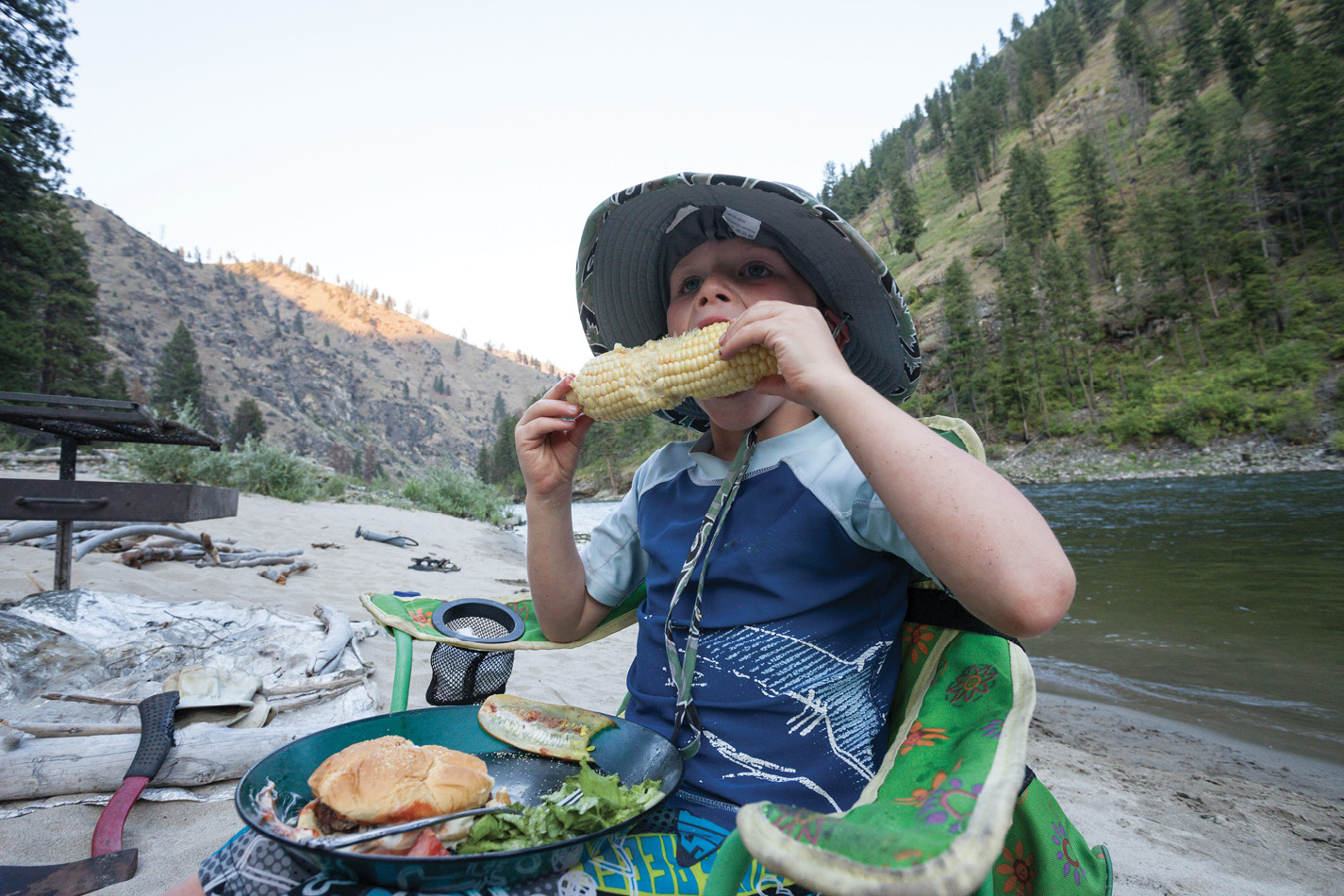
Rafting with big coolers and lots of ice allows you to enjoy fresh produce and meat throughout your river trip.
If you are going the “everything but the kitchen sink” way, you can bring frozen food and fresh produce to help diversify your menu. The goal is to have sufficient quantity and variety for everyone on the trip. People need to be well fed to avoid food stress, which can put a damper on any outdoor adventure. The amount of time and energy you want to put into your meals depends on your river. If you anticipate long days on the water, simple foods are preferable. Short days with lots of camp time allow you more flexibility for creativity and complexity.
If you are looking to travel as lightly as possible, consider dehydrated foods, one-pot meals, and concentrated foods such as energy bars, cheeses, and preserved meats like salami. Borrow ideas from backpackers to help lighten your load and minimize your space needs. The advantage to going light is that you need fewer rafts, less propane for cooking, and your rafts will be lighter and more maneuverable in rapids.
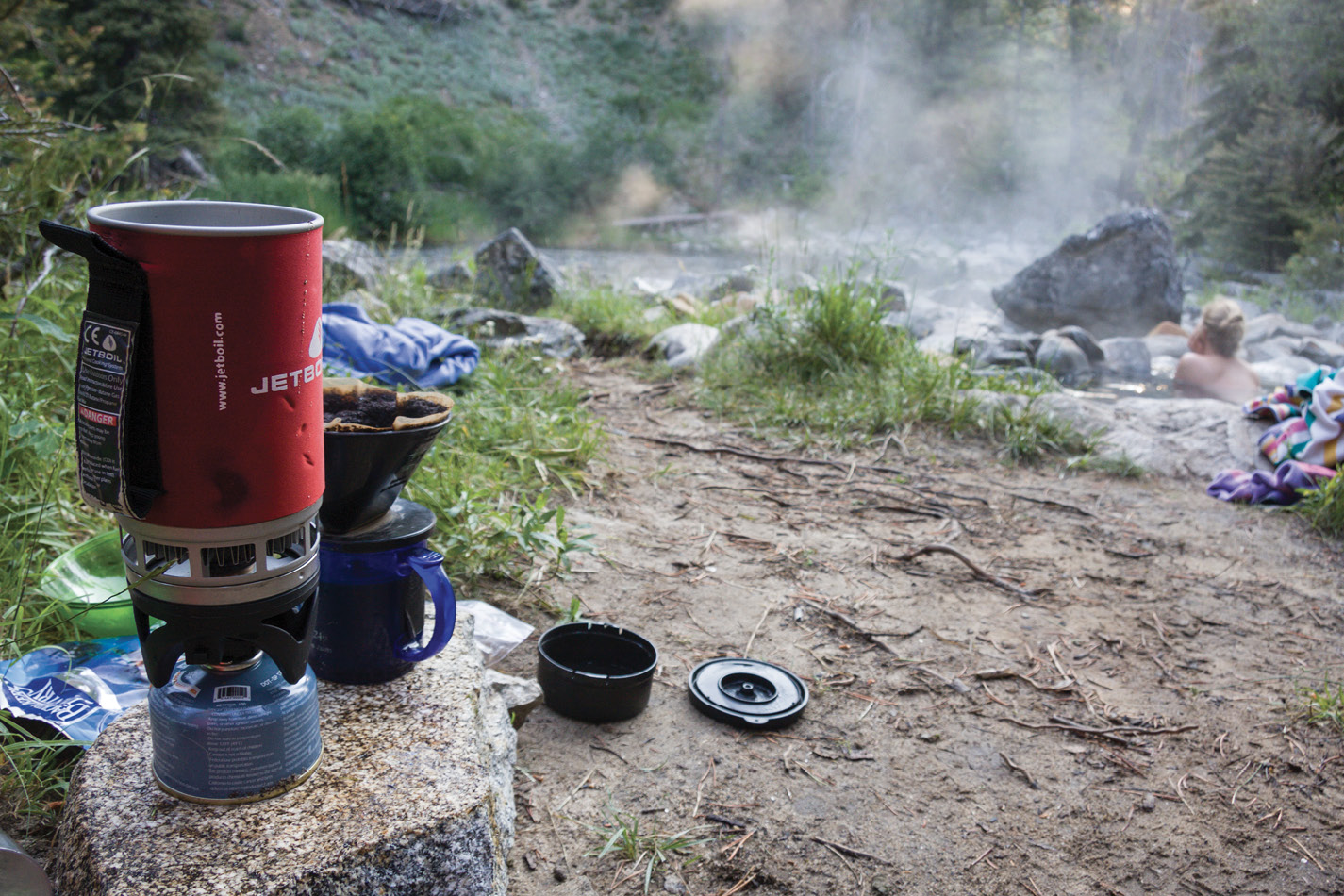
If you want to go light, bring a backpacking stove with a small pot and freeze-dried or dehydrated food so you can leave the coolers, elaborate kitchen setups, and big propane tanks behind.
Food Service Safety
A river trip can turn into a nightmare if everyone ends up sick from improper food preparation and care. This is not something to be taken lightly. There have been times when sick river runners have contaminated camps along a river, so cleanliness is critical. Make sure to set up a hand-washing station near the toilet facilities so it’s easy to wash up after you use the bathroom. Hand-washing before food preparation and eating is also critical.
In camp, be sure food is stored properly to avoid encounters with rodents, insects, bees, bears, and other animals. Dry boxes and coolers with animal-proof clasps are critical to keep your food and the animals safe. If you are in bear country, you may want to bring bearproof canisters or barrels.
Clean and sanitize dishes after every use.
If you have group snacks that come in a big container, have people pour the snacks into their hands rather than dig in to grab some. This helps keep dirty hands out of group food.
Dishwashing
River runners typically use a three- or four-basin wash system to ensure all dishes are cleaned and sanitized after every use. Plastic bins, collapsible buckets, or metal “chickie” pails that can be stacked inside each other for storage work well for this system. The advantage of chickie pails is they can be placed directly on the stove or blaster for heating wash water.
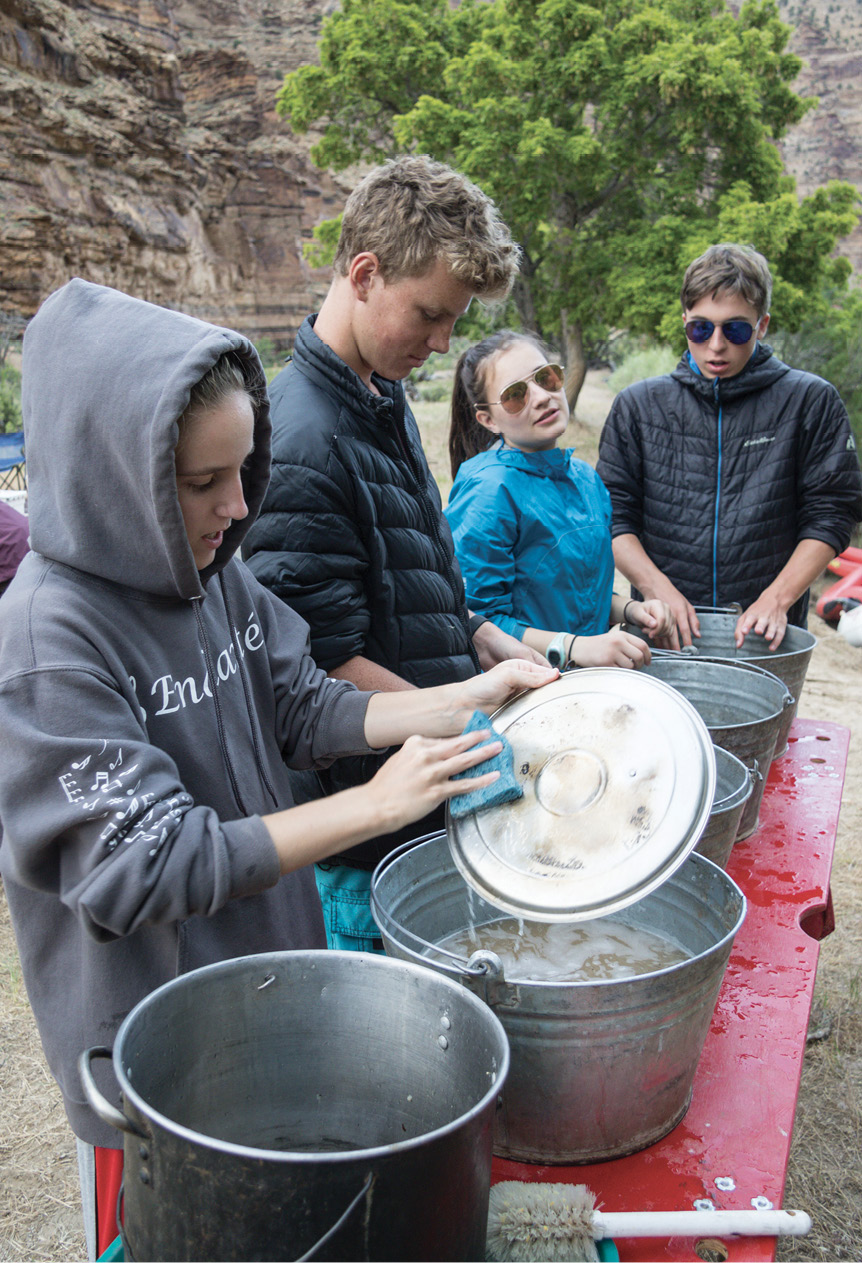
To wash your dishes, start by scraping food scraps into the garbage. It’s nice to have an extra spatula to help with this task. In a four-basin system, the first basin is used for a prewash, which allows you to get rid of the gunk or scraps that dirty dishwater quickly. This step isn’t critical, but some people like it. The next three containers are vital, however.
Clean, sanitized dishes help ensure that no one gets sick during your trip.
The first basin in a three-basin system contains warm soapy water for washing. The second basin contains warm or cold rinse water. The third contains cold rinse water with half a capful of bleach to sanitize the dishes. Hot water deactivates bleach, hence the reason your final rinse must be cold. On clear rivers, you can use river water for dishes. If the river is silty or muddy, it may be best to use jug water, in which case it is important to be conservative but still thorough. Alternately you can pull silty water from the river and let it sit in a bucket until the silt settles out before pouring it into your washing basins.
Make sure to start washing the cleanest dishes first so the dishwater stays cleaner longer. Dishes must be in the bleach water for thirty seconds to be sanitized.
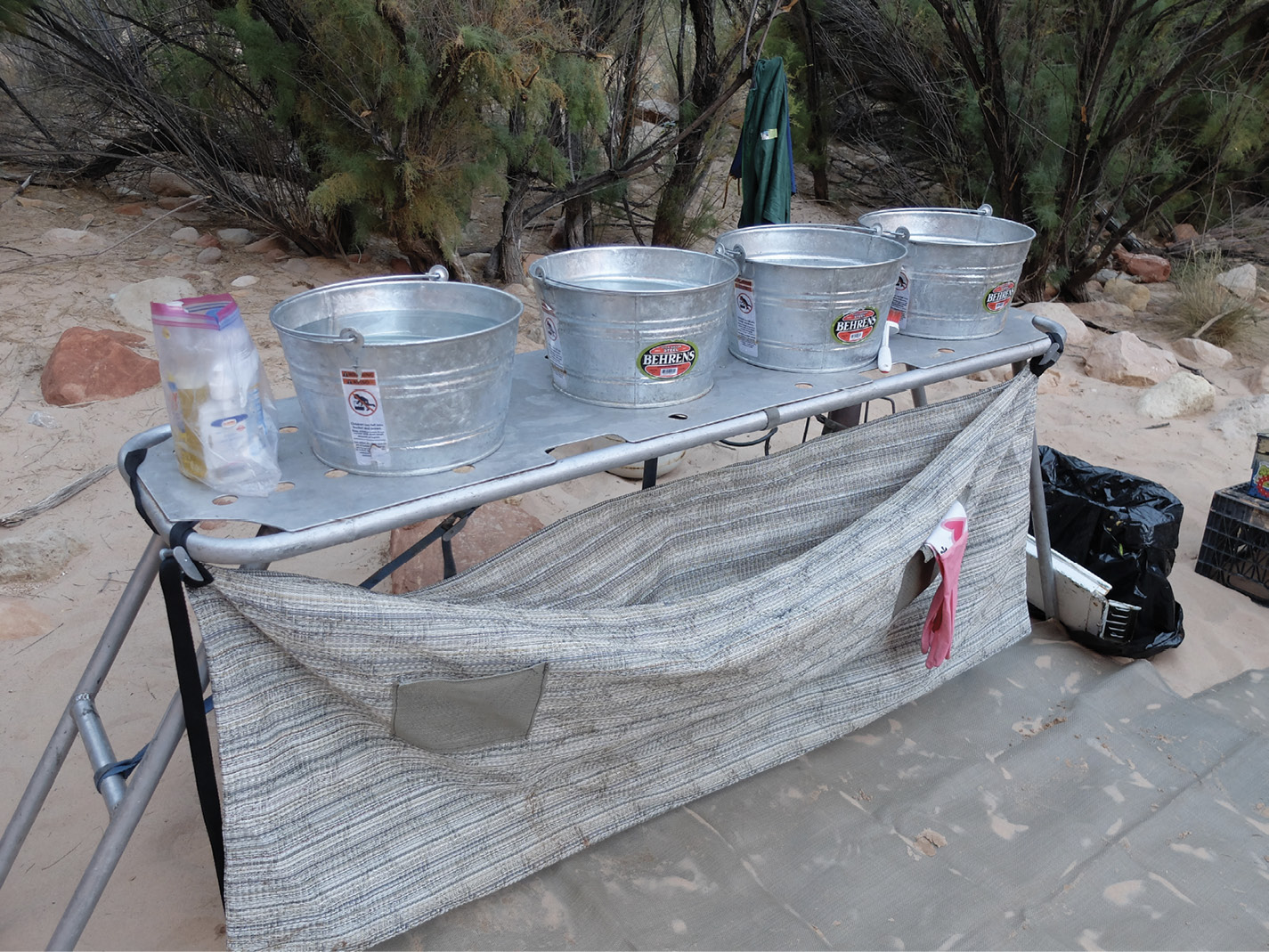
Set up your dishwashing station so it’s convenient and easy to use. That way washing is less of a chore for everyone.
Once the dishes are washed, place them in a mesh drying hammock suspended from a table. The dishes can stay here overnight. If you need to pack up to get on the river, let the dishes air dry as long as possible and then pack them up.
Wastewater is strained through either a metal or cloth strainer, and all remaining food particles collected in the strainer are placed in the garbage. The leftover gray water is either disposed of in the river or above the high-water mark. This decision is determined by the specific river regulations. Water is usually poured into the river on desert or glacial rivers, but is not on clear mountain streams.
Dishwashing can be brutal on your hands, especially on longer river trips. Pack a couple of pairs of dishwashing gloves to protect your skin. Make sure to store the gloves in a dry box overnight so mice don’t make holes in them.
River Breakfasts
River breakfasts can be cold or hot. The type you choose is largely a reflection of your time constraints. Go with cold on mornings when you want to get out of camp fast, and hot when you have more time.
Cooked breakfasts can include French toast, pancakes, hash browns, or egg sandwiches. You can make things like breakfast burritos at home and heat them up (or eat them cold) on the river for an easy breakfast. Baked goods made before your trip are also popular. You can include meat, such as bacon or sausage. (Cleanup after cooking breakfast meat can be time-consuming, so be sure to factor in time to drain grease and clean greasy pans when having bacon or sausage for your morning meal.)
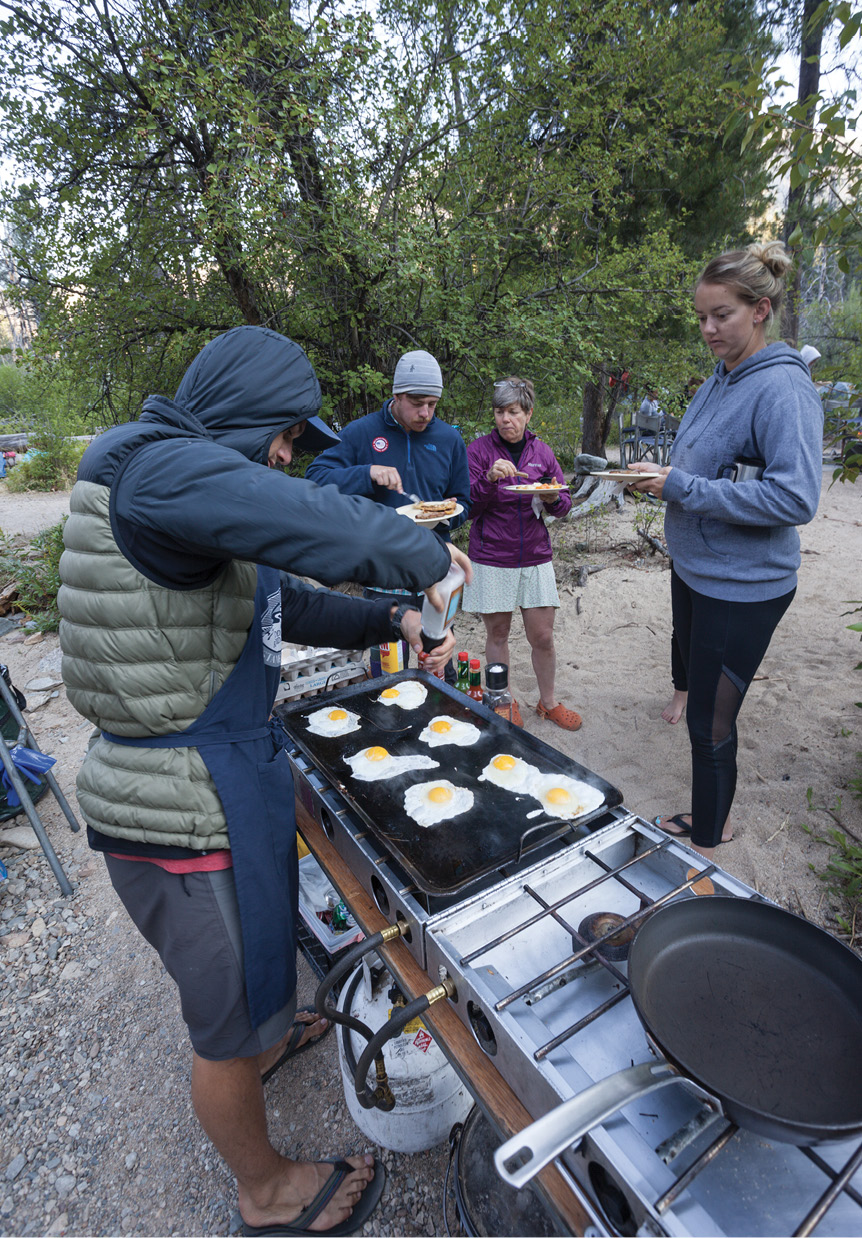
Hot breakfasts on the river can range from fried eggs to pancakes or French toast.
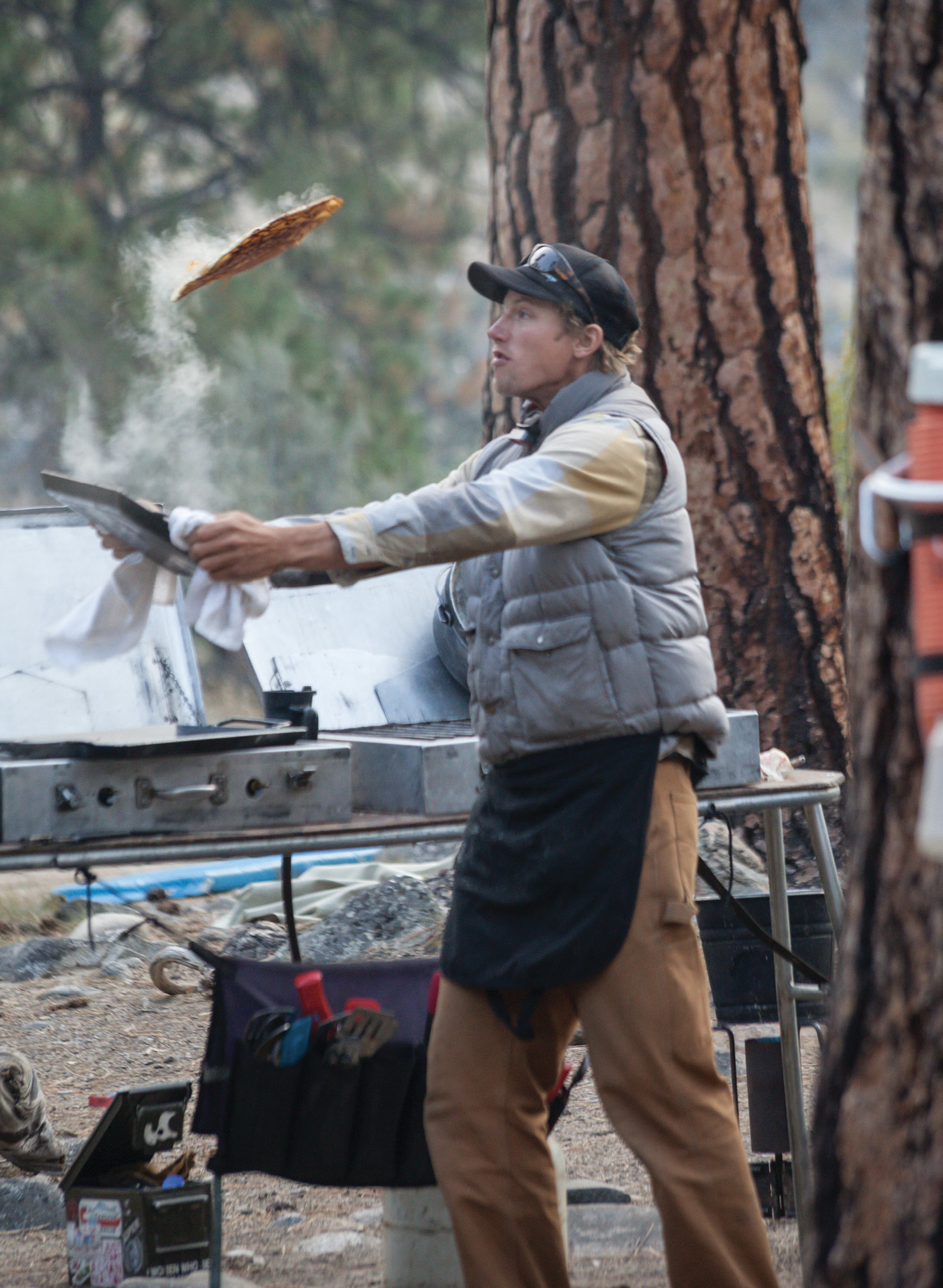
Cooking on the river is a time to unleash your inner chef.
Cold breakfasts usually involve cereal with milk, yogurt, or a milk substitute like Rice Dream. It’s nice to include three or four different types of cereal so people have a choice. Fruit can round out the meal. Melon holds up to packing well but takes up a lot of space. Apples and oranges are also good options for rivers because they tend to withstand travel.
Most breakfasts start with a hot drink, usually coffee, tea, or hot chocolate, so even with cold breakfasts you’ll need to boil water.
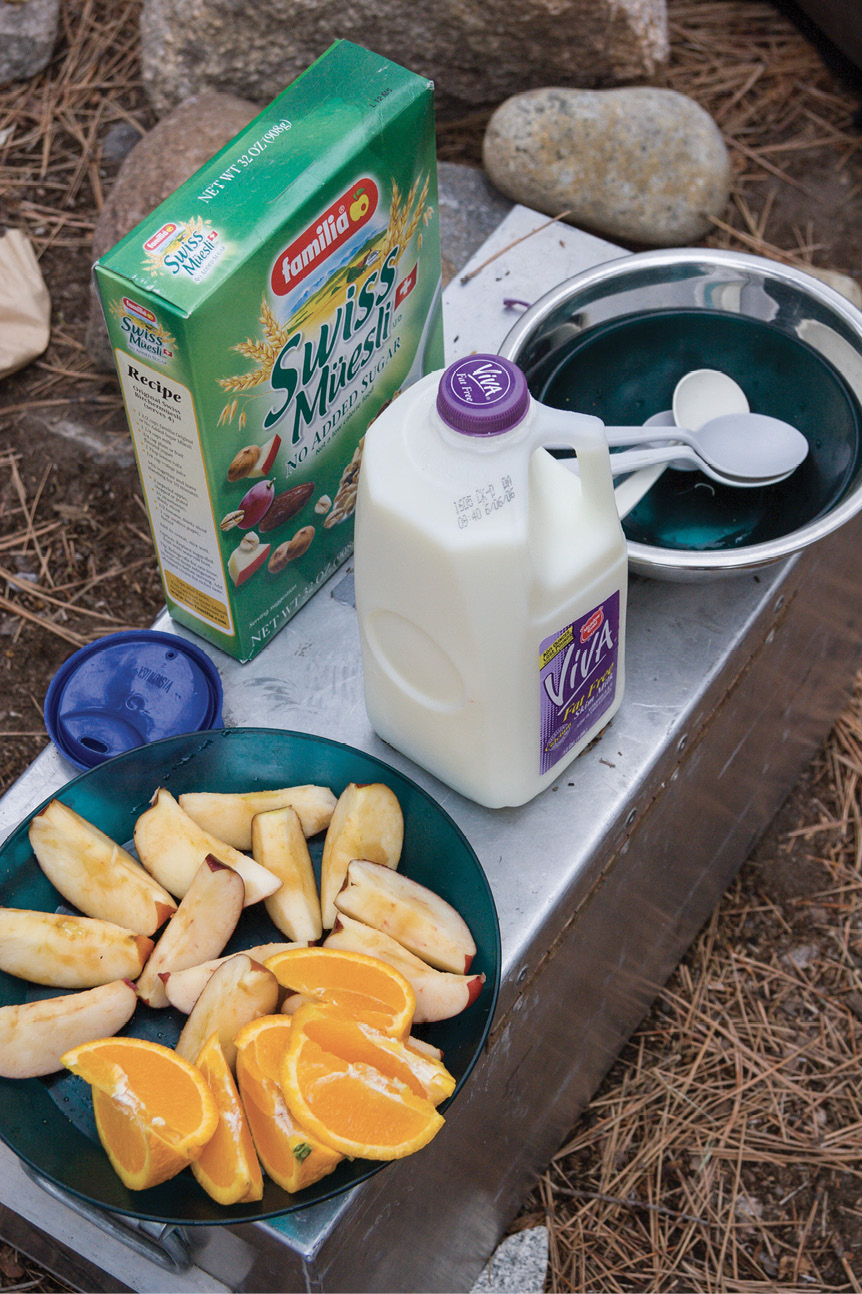
Breakfast doesn’t have to be elaborate. If you anticipate a long day or want to make the food on your trip simple and easy, you can have cereal and fruit for a quick, easy meal.
River Lunches
Lunches can be a formal affair, where you pull out a table and make an elaborate meal, or can be simple, where you pack a lunch at breakfast and eat on the fly during the day. Some groups I’ve traveled with like to have individuals bring their own lunches so they can eat whenever they feel like it as they float downstream. This works well when everyone is in his or her own raft with access to a cooler and food storage. If your trip includes a lot of kayakers or people in small boats, it’s usually easier to do a group lunch, or to have people pack their lunches in the morning after breakfast so they have access to it during the day.

On upscale river trips, lunches can be elaborate affairs complete with tablecloths, fresh fruit, cold cuts, cheese, veggies, and dessert.
One of the most common river lunches is a sandwich buffet with a variety of breads, cold cuts, sliced cheese, hummus, lettuce (iceberg travels well), tomatoes, pickles, avocados, etc. You can also make chicken or tuna salad, pasta salad, or three-bean salad for some variety. Tortillas are great for making wraps and are a good alternative for lunches later in the trip, when bread may be getting moldy or smashed in the dry boxes. Pringles make a good river snack since they hold up to packing better than bagged chips. Cookies and fruit round out the meal. The key is to offer some variety so people can pick and choose what suits them.
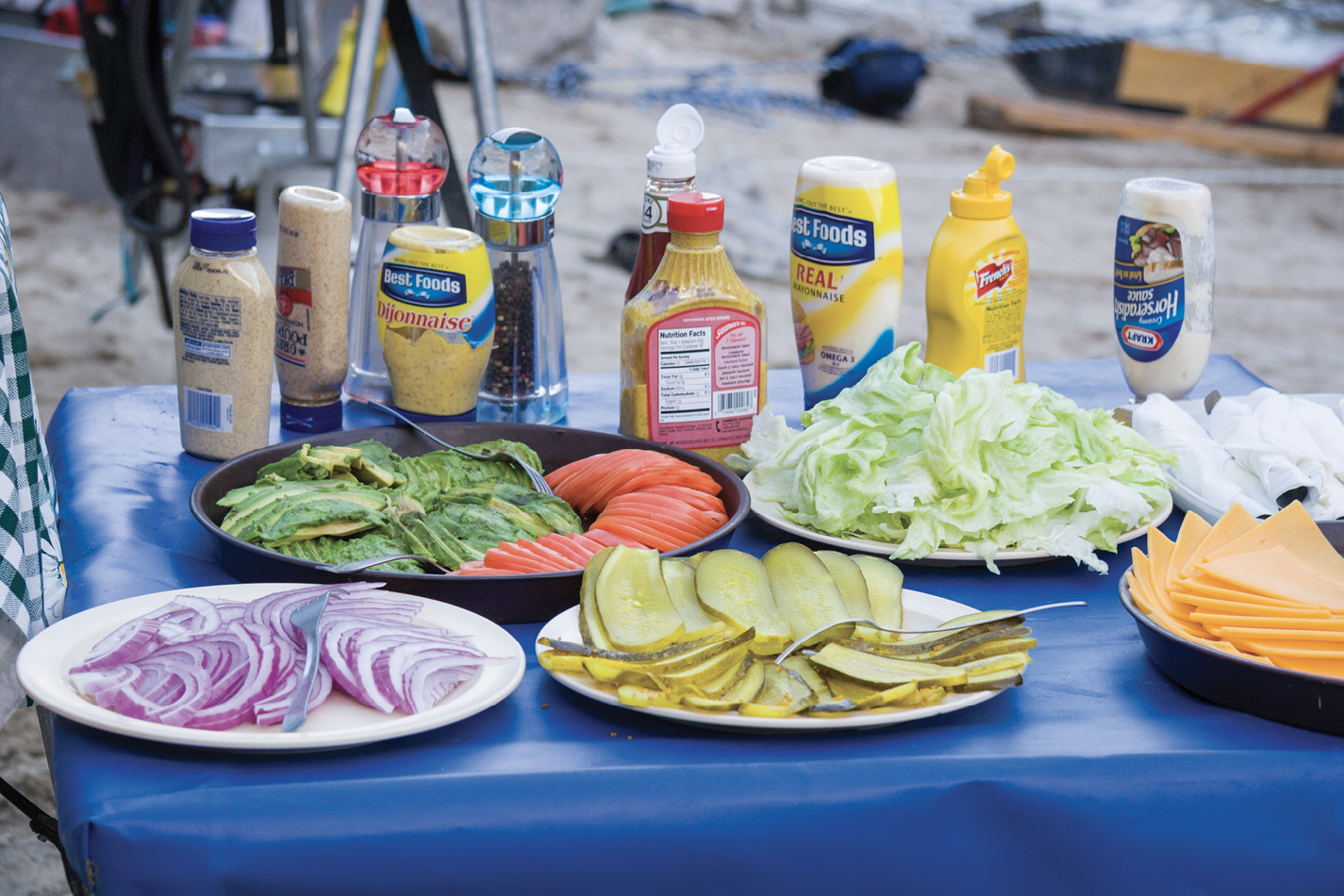
A yummy but basic lunch spread includes cold cuts, cheese, lettuce, tomatoes, avocados, onions, pickles, and bread.
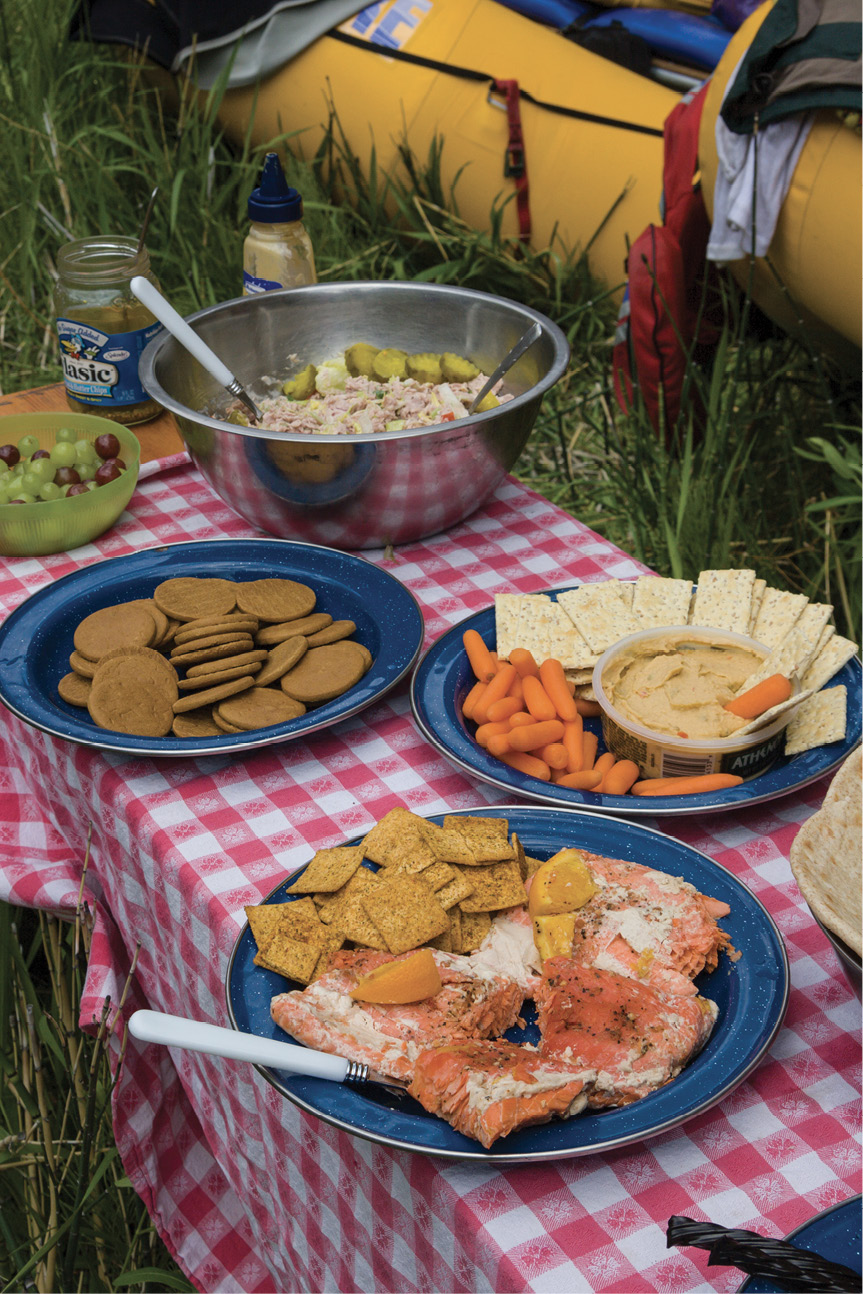
If you want a change from cold cuts, you can have cold salmon, hummus, or chicken salad for lunch.
Make sure to identify any utensils or dishes that you’ll need to prepare your lunch, and put them in a special spot before the rafts are packed so they are easy to find when you pull over for lunch.
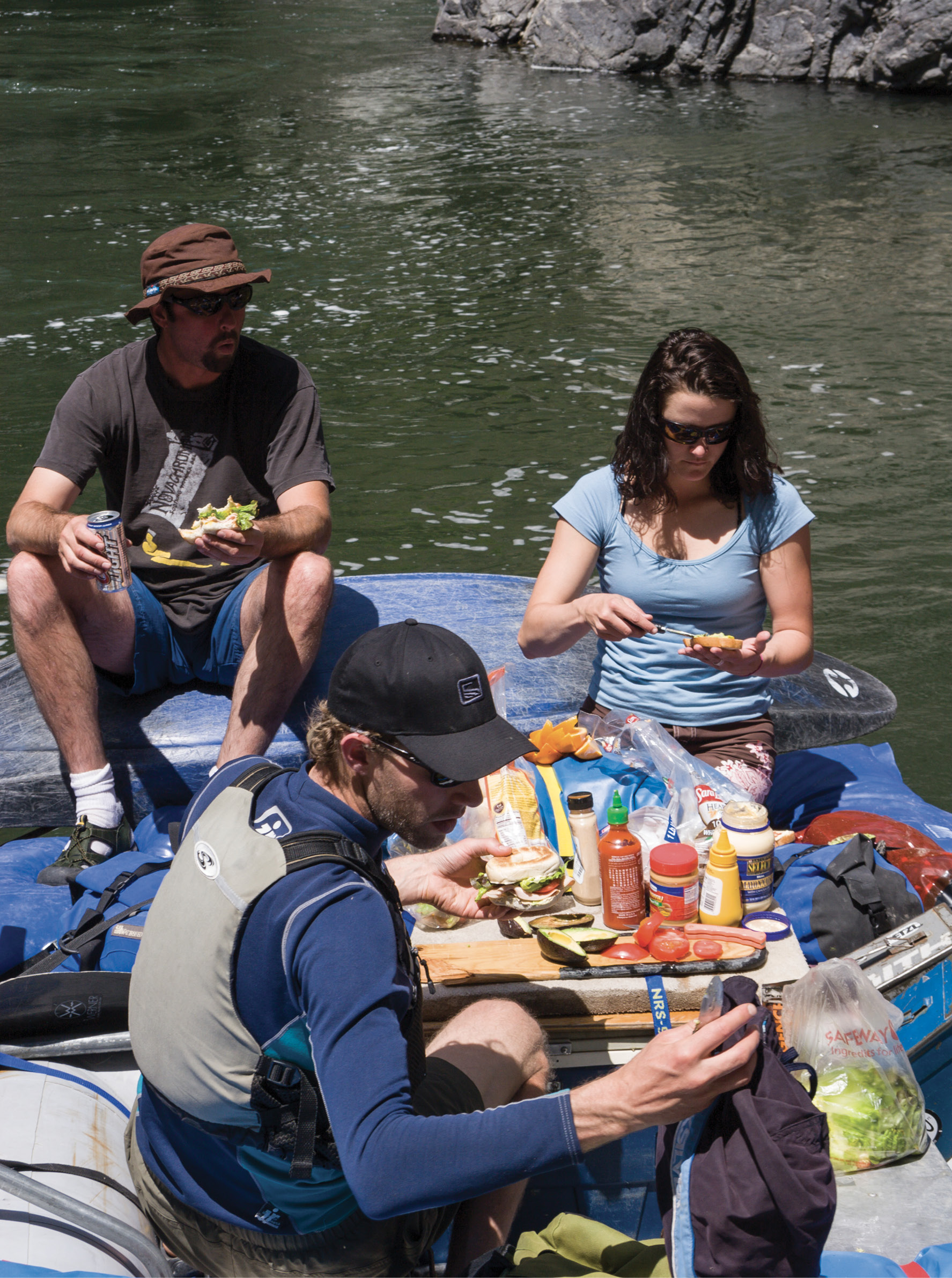
If you have a long day on the river planned, you can always just eat lunch on the raft. Make sure you put everything you need in a handy place when you load your boat in the morning to expedite your picnic.
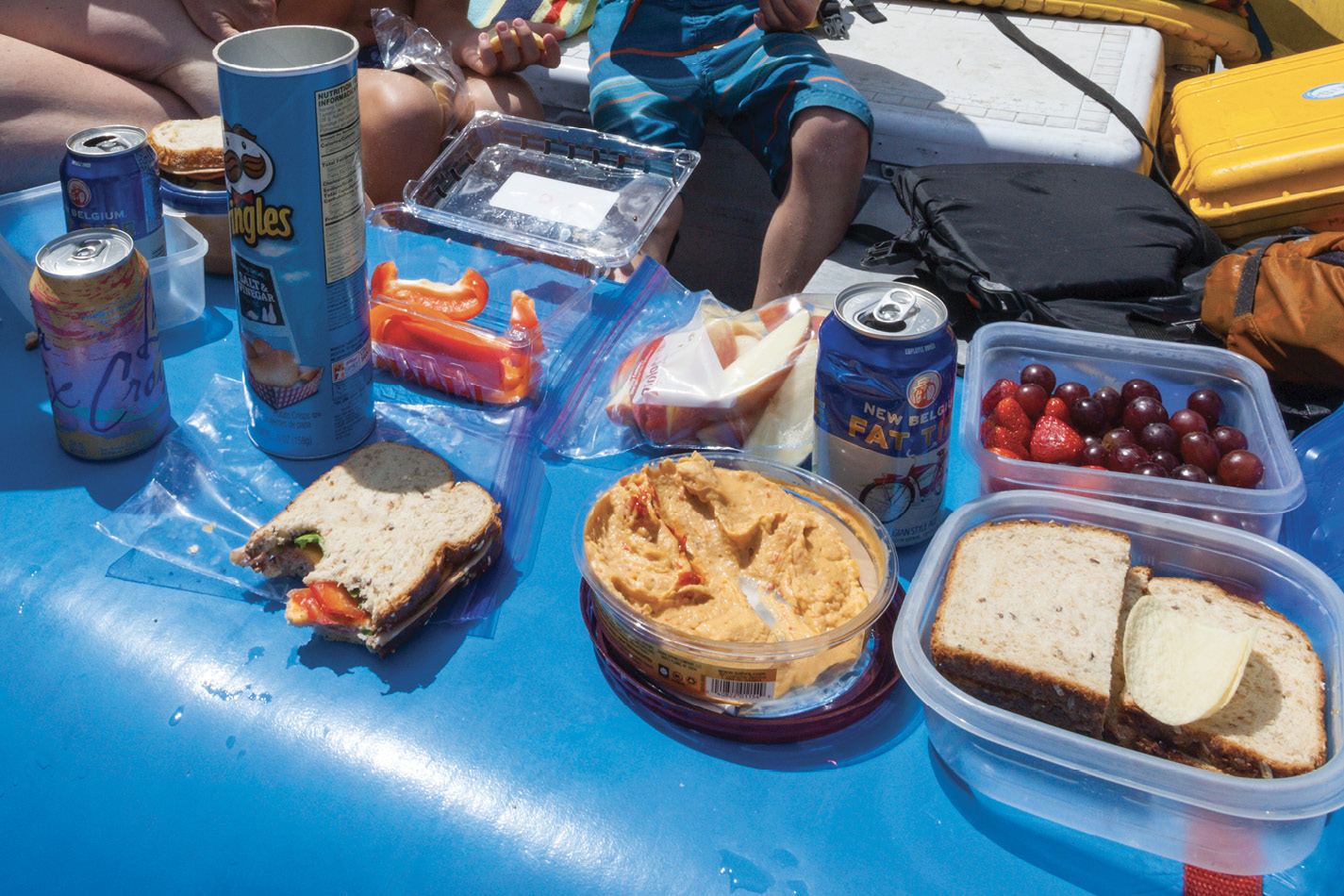
If you think you’ll be eating a lot of lunches on the go, it’s a good idea to pack some plastic containers so you can make your sandwich in camp in the morning and eat it whenever you get hungry during the day.
Snacks
Have some snacks readily available for people throughout the day. Many groups opt to have individuals bring their own snacks so they have sufficient amounts and options. Energy bars, trail mix, pretzels, gorp, crackers, mixed nuts, and candy can all provide a quick boost on a long day. Have people put their snacks in their day bags so they can get to it without having to open dry boxes or a cooler.
If it’s cold, a few insulated bottles for hot drinks can help chilly boaters revive.
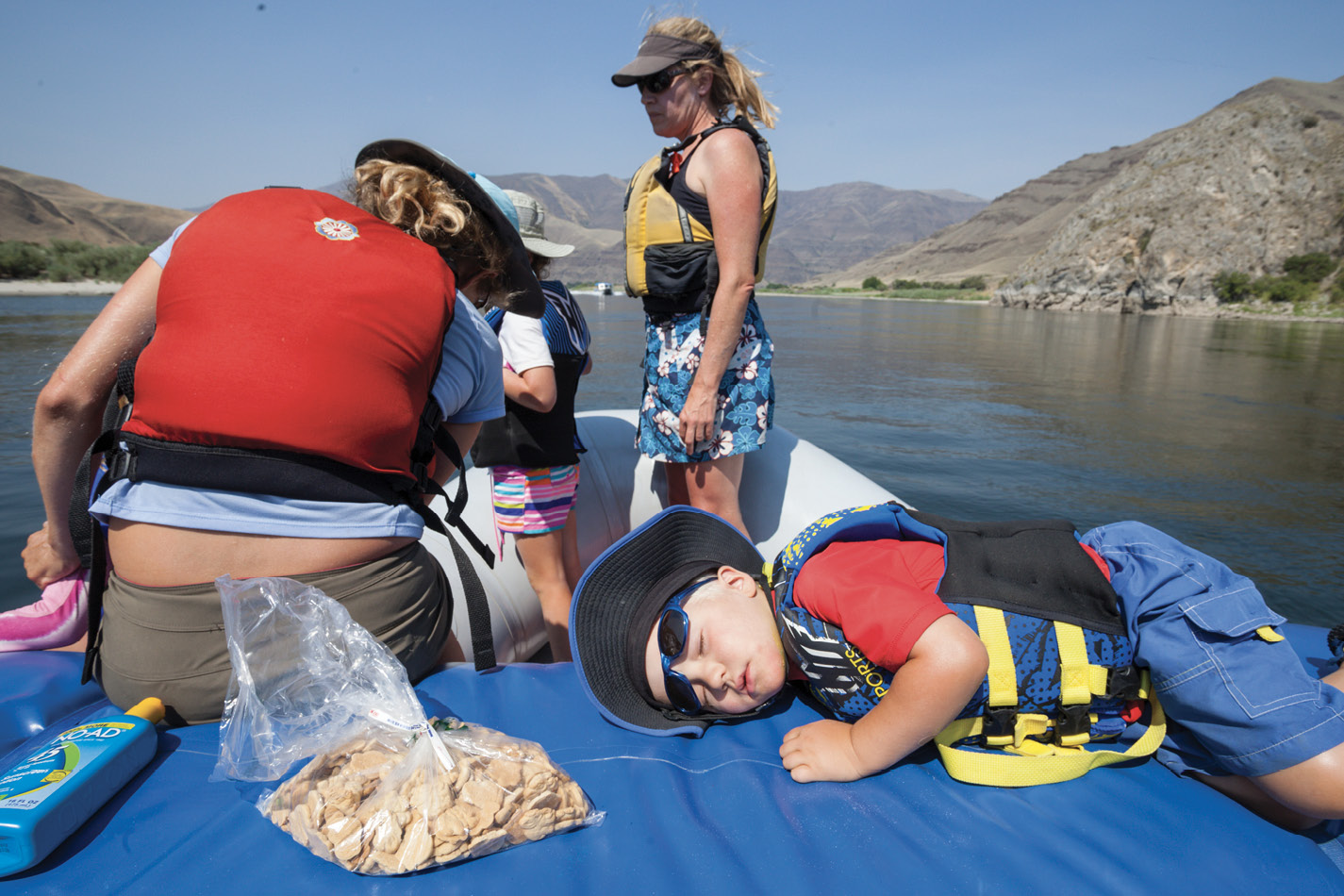
Keep some snacks—bars, gorp, crackers, etc.—easily accessible so people, especially kids, can eat when they need some extra calories to get through the day.
River Dinners
Dinners can also run the gamut from simple to complex. Many rafters bring Dutch ovens so they can bake or make casseroles on the river. Others opt to prepare and freeze a meal at home so all they have to do on the river is reheat it. Weight is generally not a concern unless you are trying to go light or are on a long river trip with a lot of people.

Dutch oven lasagna is a special hearty treat that tastes great after a hard day of boating.
Dutch Ovens
Dutch ovens (DOs) can be used for baking breads, cakes, and casseroles like lasagna, or can be used as a warming dish.
To use a DO for baking, set up your fire pan to heat the coals. You’ll need thirty to forty briquettes per DO. Wipe the DO with an oiled paper towel or empty butter wrapper and load it up with whatever you are cooking. Put the lid on securely.
Spread ten to fifteen charcoal briquettes in an even layer in the fire pan and place the DO on top. Using a shovel, stack the rest of the briquettes onto the lid, spreading them out across the top.
Cooking times in the DO will vary depending on what you are preparing. Usually it takes about forty-five minutes for most recipes. You should be able to smell your masterpiece for roughly ten to fifteen minutes before it’s ready.
Allow the DO to cool before you wash it. Placing it in cold water when hot causes the metal to warp.
Drinks
Most groups have people bring their own beverages to ensure everyone has what they want to drink. You don’t have to go that route, of course, but it’s one way to ensure the one-beer-a-week person doesn’t end up having to pay for the six-pack-a-day person’s habit. It’s also nice to have some nonalcoholic drinks and drink mix to add to your water. Water that sits in warm plastic jugs all day can begin to be bit unpleasant to drink, and it’s important to keep everyone hydrated on the river.
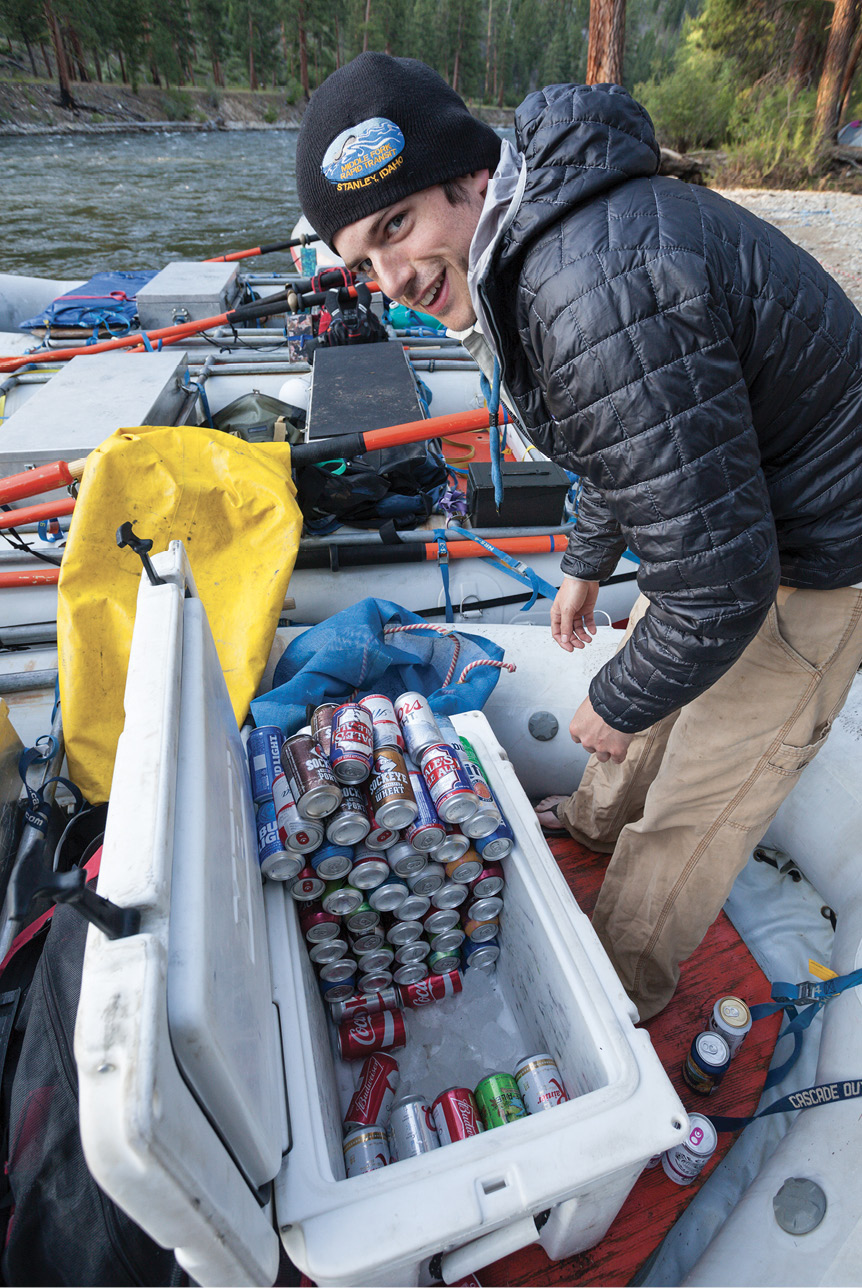
If you have the luxury of abundant cooler space, you can devote one to keeping canned drinks cold. Cans can also be put in a drag bag and towed behind the raft to chill.
On cold-weather trips, pack a few insulated bottles to hold tea or cocoa for a quick pick-me-up on the river.
Water
Where you get your drinking, cooking, and washing water depends on the river you are on. On some trips you get by with getting all your water directly from the river (although it should be treated if it’s not boiled). On other rivers, you may opt to bring drinking water in 5-gallon jugs and get the rest of your water (for washing and cooking) out of the river. On still other rivers (especially those with a lot of runoff from farms, glacial silt, or sediment) you may want to bring all the water you plan to use—except for washing water—in jugs. Jugs can be refilled from springs or clear side streams as you empty them.
Food Amounts
One of the hardest things about planning a river menu is figuring out how much food is enough. It can be helpful to check with your group members before the trip to find out if they consider themselvves to be big eaters, light eaters, or just average. Young children and older people tend to eat a bit less than your average adult. Teens can put down a lot of food, especially teenage boys.
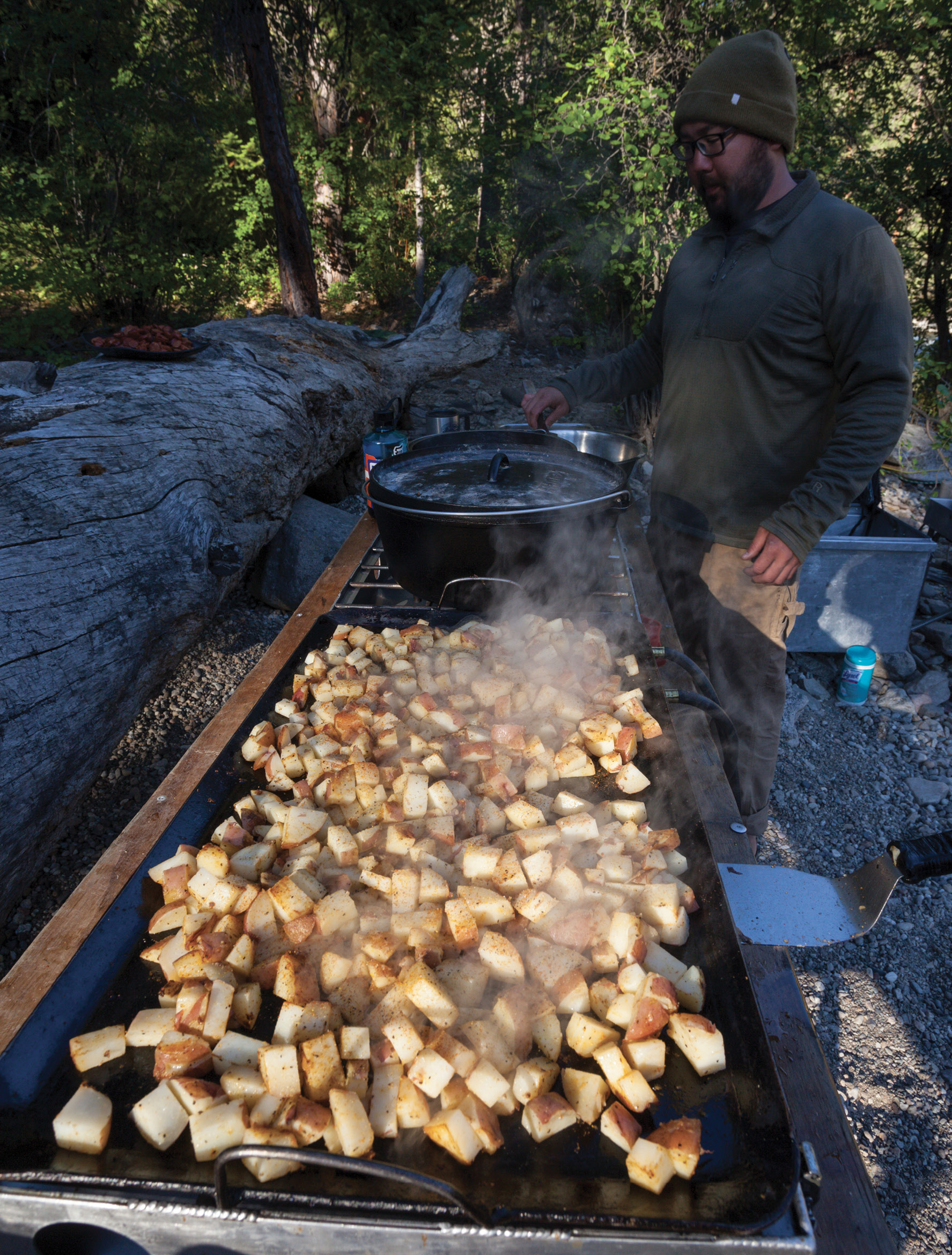
It’s nice to have plenty of food, but having too much is a drag and a waste. Plan your amounts carefully, and if you find the group isn’t eating everything you prepare, cut things down to avoid having leftovers to throw away.
In general, I like to use the serving guidelines on recipes as a starting point and then round up or down based on the composition of my group, as well as the weather conditions and the level of exertion anticipated on the trip. Cold-weather trips typically mean boaters need more calories. Hot-weather trips often call for more drinks, sodas, and fruit.

If you are a meat eater, a steak dinner cooked over the coals can’t be beat, but make sure you know your group’s dietary preferences before serving meat.
Food Quantity Guidelines
When it comes to how much food people will eat, every group is different. You need to find the balance between having too much food (i.e., leftovers) and not having enough. Remember, your group will start out eating light and then eat more as the trip progresses. Take into account the ages of people in your group (kids eat less), the number of people, boy versus girl ratio, daily activities that may require extra energy, etc.